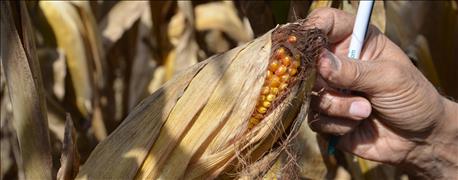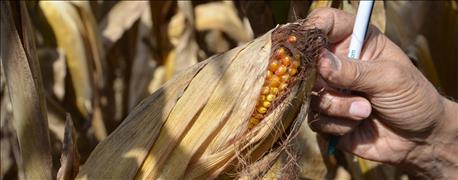November 23, 2016

Every growing season adds to our knowledge or reinforces certain ideas, so we can keep improving our crops and increase yields. Based on last year’s lessons, I would like to emphasize these 10 points.
1. Tiling your fields is very helpful in wet years.
If your fields aren’t tiled, it’s a good investment for the long term. Fields which were tiled dried sooner and could be planted earlier in 2016.
2. Be very selective in choosing corn hybrids and soybean varieties.
Pay more attention to disease resistance. Select hybrids which are consistent performers over several years and locations.
3. If you’re going to switch planters, think about narrow rows.

PLANNING PAYS: If you want a field full of ears like this one next year, you need to start planning now.
Corn breeders in many companies have already developed the shorter, Christmas-tree-shaped hybrids with good stress and drought tolerance and stay-green power. These hybrids have upright leaves and can be planted at higher plant densities based on your soil types.
4. Plant early if you can.
Last year’s growing season proves it again. Yes, you may get caught by a certain bad day, but you’re playing the odds. It’s better to plant too early than too late during most years.
5. Sidedressing with nitrogen is a no-brainer.
Lots of fields showed nitrogen deficiency due to nitrogen leaching. Think about using nitrogen stabilizers.
6. Foliar fungicides work if applied at the right time.
If possible, arrange for ground application after pollination is complete. You want to protect the leaves above the ears during grain-fill.
7. If you haven’t used cover crops before, try them this year.
Consider planting them after soybean harvest in 2017. You don’t have to invest in a cover crop seeder. You can plant wheat or rye blended with a little legume seed and fertilizer. To save time, have your fertilizer dealer spread it for you.
8. Plan ahead so you can get cover crops seeded on time.
We need to plant cover crops earlier if we want to include daikon radishes in the mix to help with soil compaction problems. Choosing the right cover crop for your operation is important. Letting the fertilizer dealer help you may be an option, while you complete your harvest.
9. Early weed control is important.
Early weeds hurt yields. If you use one herbicide like glyphosate for both corn and soybeans, resistant weeds will develop. Don’t let nasty weeds like Palmer amaranth get established on your farm!
10. Corn borer is alive and well in spite of the use of Bt hybrids for a long time.
Damage on non-GMO cornfields has been reported from Ohio to Iowa. If you use corn with traits, make sure to use refuge corn if it isn’t in a one-bag solution. We don’t want resistant corn borers.
Bonus tip: The Crop Watch ’16 project field in central Indiana emphasized the importance of scouting until harvest. Corn in this field didn’t show much disease by mid-August, but September rains and high temperatures changed the picture. By mid- to late September, it was full of gray leaf spot, anthracnose and diplodia. The message is: Keep scouting until harvest!
Nanda is president of Agronomic Crops Consultants LLC. Email him at [email protected] or call him at 317-910-9876.
About the Author(s)
You May Also Like






